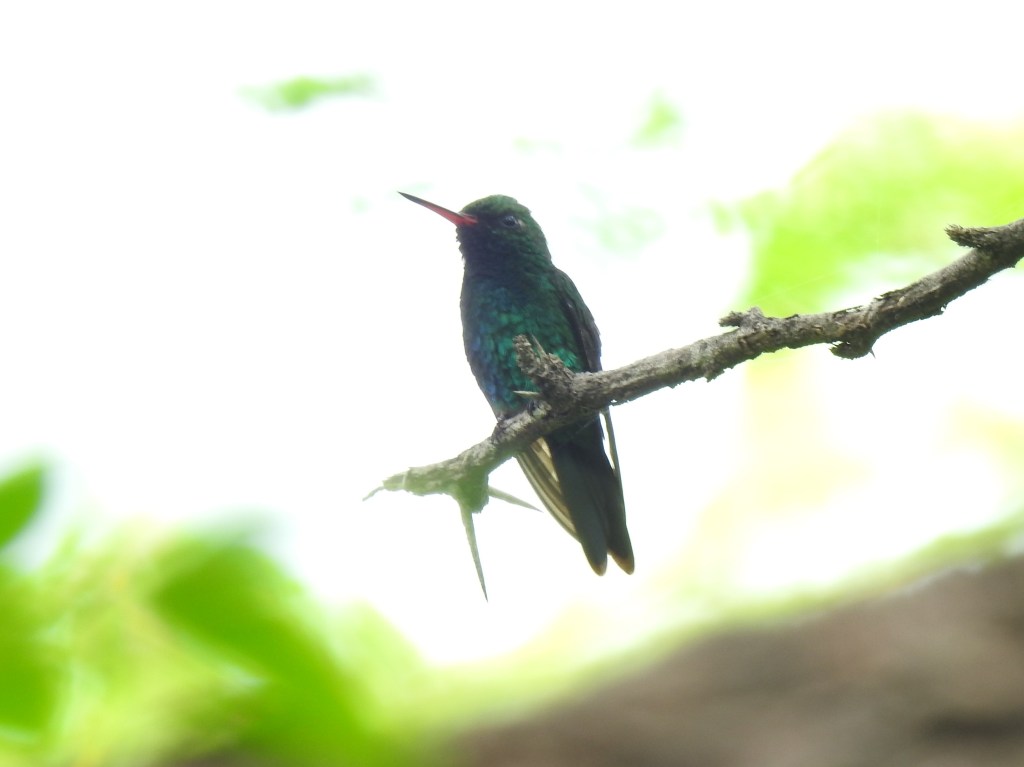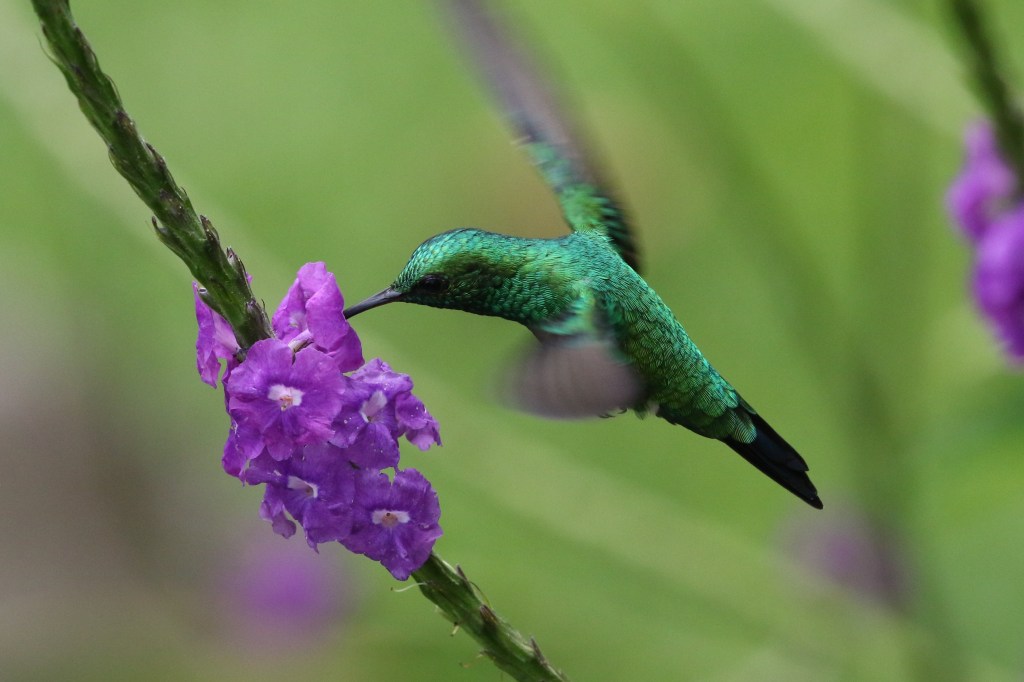Garden Emerald (Chlorostilbon assimilis): Esmeralda jardinera; Gartensmaragdkolibri; Emeraude du Panama
There are 4 species of hummingbirds resident in Costa Rica that bear the name “emerald”. A fifth, the White-bellied Emerald (Amazilia candida), has been recorded from the Río Tule, Nicaragua, not too far from the border at Los Chiles. It is thus hypothetically a resident on our side of the Río San Juan, but cannot be considered here.
And if you are here in the Turrialba area, the only Emerald you’re likely to see is the very small Garden Emerald (Chlorostilbon assimilis). As its name indicates, this is a not a bird of the closed forests. Currently, a male is trying to compete with the Rufous-taileds and other hummingbirds in John’s garden in Santa Rosa. The male is a true beauty – all glittering green is the first impression:

It is a lowland hummer that despite the many local reports managed to escape me in my first years in Turrialba. It is found only in Costa Rica and Panama – indeed, its French name translates to ‘Panama Emerald’. My initial encounters with it came thanks to local guide Steven Aguilar, who regularly finds it at a rabo de gato hedge near San Rafael de Pavones on the Turrialba-Siquirres road. Known as porterweed in English, this plant, which is found country-wide, is a great favourite with hummingbirds and other small nectar-seekers such as the Bananaquit (Coereba flaviola).
The Garden Emerald has now also visited my neighbour Sue Magree’s feeders, as well as her porterweed, on more than one occasion. This is in San Rafael de Santa Cruz, at an elevation of almost 1300 m and quite close to my home, where I still confidently expect it to appear one day. In the meantime, here are beautiful photographs of the male now appearing in nearby Santa Rosa:


It’s a good idea to note the colour of the bill because a closely related species, Canivet’s Emerald (Chlorostilbon canivetii), is virtually identical. Fortunately, any confusion can be solved because Canivet’s has an essentially red bill – especially the first half, starting from the base. Supposedly there is no range overlap, but this species has been recorded repeatedly at Ujarrás and the vicinity of Lago Cachí, a mere 25 km west of Turrialba. This is slap bang in the Garden Emerald’s normal range and well out of Canivet’s usual territory, which is mostly the northwestern parts of the country. To complicate matters, there is one very recent and accepted (so far) report of Canivet’s Emerald on the very outskirts of Turrialba from Sitio Mata – the first ever for us as far as I can tell. This report may yet be withdrawn for lack of evidence, it seems.
Here’s a male Canivet’s Emerald seen at Playa Grande in the Nicoya Peninsula:

What about the other two Costa Rican Emerald species mentioned earlier? These are the White-tailed Emerald (Elvira chionura) and the Coppery-headed Emerald (Elvira cupreiceps) respectively but I can find no well-substantiated report of either species for Turrialba and you are most unlikely to bump into either one here. Their respective English names indicate how to identify them, but in addition the Coppery-headed has a clearly decurved bill if seen well.
The nearest well-established report of the White-tailed Emerald – a species of mostly higher elevations that is found only in the southern half of the country and in Panama – is from Tapantí National Park in 2015. On the same day and at the same location, local expert Ernesto Carman reported Coppery-headed Emerald, but this Costa Rican endemic (mostly found in the north) is common enough in that area. As with the White-tailed Emerald, there are no well-supported sightings at all from Turrialba, though a recent report from Reserva La Marta – 26 km away – seems very credible.
Before looking at the female Garden Emerald, which is so different as to seem to a casual observer to be a different species, here is a final action shot of the male Garden Emerald currently visiting Santa Rosa:

Beware of females! Identification problems often occur with hummingbirds because of the sometimes big differences in plumage between the sexes. This is certainly the case with the Garden Emerald. Take a look at a female of the species that visited John’s garden in February of this year:

The pale underparts will probably remind North American visitors of their female Ruby-throated and Black-chinned Hummingbirds, but the female Garden Emerald has a white post-ocular stripe, which often shows up well.

This helps to further distinguish it from other Costa Rican resident hummers, in particular the female Snowcap (Microchera albocoronata), which is widespread and common in some localities in our area.
My best thanks go as always to John Beer for the wonderful photographs and also for his very timely suggestions regarding these regular postings of contributions on the distribution of bird species in Turrialba.
Finally, for regular followers of this blog I have now revised my San Antonio Bird Checklist (My Patch) to include all species noted by me personally within a walk of my home. This gives a very accurate idea of what can be expected in close proximity to San Antonio. The updated list can be found among my Pages.


Beautiful! 🙂
LikeLike
When the coronavirus crisis is over you should bring your camera to Costa Rica and add to your own great photo collection.
LikeLike
Very tempting offer. When is the best time to find more birds? How many days are needed?
LikeLike
Best is between October and early April because then nearly all the migrants are there. It’s a small country but you’ll find huge variety between mountains and beaches, between Pacific and Caribbean, and between the dry northwest and the southern Pacific. I’ve been here 12 years and have still seen only about two thirds of the bird species, for example.
LikeLiked by 1 person
I’d love to take my son (12 next year) and explore in Costa Rica. Once the virus pandemic is over. Thanks, Paul. 🙂
LikeLike
Great photos(John Beer) and wonderfully descriptive and informative commentary (Paul)). During this pandemic and lockdown they provide an escape, dream of better days to come, maintain our sanity.
Still can’t believe it’s been 12 years since you left here!
Darryl
LikeLike
Seems like yesterday! Drop me an email.
LikeLike